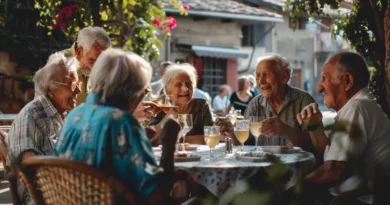Neste vídeo do canal TED-Ed você vai matar de vez a sua curiosidade, descobrindo o segredo por trás da localização estratégica das empresas concorrentes! Por que elas abrem suas lojas lado a lado? Neste fascinante vídeo, é desvendado o Modelo de Competição Espacial de Hotelling e como ele explica esse fenômeno. Prepare-se para entender por que sorveterias, postos de gasolina e restaurantes parecem sempre se agrupar, em vez de se espalhar uniformemente. Acompanhe essa jornada de estratégias comerciais e equilíbrio de poder entre os concorrentes. Você ficará surpreso com os insights revelados!
| Audio | |
|---|---|
Normal | Slow |
| English Transcript | Tradução |
| Why are gas stations always built right next to other gas stations? | Por que os postos de gasolina são sempre construídos ao lado de outros postos de gasolina? |
| Why can I drive for a mile without finding a coffee shop and then stumble across three on the same corner? | Por que posso dirigir por um quilômetro sem encontrar uma cafeteria e depois tropeçar em três na mesma esquina? |
| Why do grocery stores, auto repair shops and restaurants always seem to exist in groups instead of being spread evenly throughout a community? | Por que mercearias, oficinas mecânicas e restaurantes sempre parecem existir em grupos, em vez de estarem espalhados uniformemente por uma comunidade? |
| While there are several factors that might go into deciding where to place your business, clusters of similar companies can be explained by a very simple story called Hotelling's Model of Spatial Competition. | Embora existam vários fatores que possam influenciar a decisão de onde colocar seu negócio, grupos de empresas semelhantes podem ser explicados por uma história muito simples chamada Modelo de Competição Espacial de Hotelling. |
| Imagine that you sell ice cream at the beach. | Imagine que você vende sorvete na praia. |
| Your beach is one mile long and you have no competition. | Sua praia tem uma milha de comprimento e você não tem concorrência. |
| Where would you place your cart in order to sell the most product? | Onde você colocaria seu carrinho para vender mais produtos? |
| In the middle. | No meio. |
| The one-half-mile walk may be too far for some people at each end of the beach, but your cart serves as many people as possible. | A caminhada de meia milha pode ser muito longa para algumas pessoas em cada extremidade da praia, mas seu carrinho atende o máximo de pessoas possível. |
| One day you show up at work just as your cousin Teddy is arriving at the beach with his own ice cream cart. | Um dia você aparece no trabalho no momento em que seu primo Teddy está chegando à praia com seu próprio carrinho de sorvete. |
| In fact, he's selling exactly the same type of ice cream as you are. | Na verdade, ele está vendendo exatamente o mesmo tipo de sorvete que você. |
| You agree that you will split the beach in half. | Você concorda que dividirá a praia ao meio. |
| In order to ensure that customers don't have to walk too far you set up your cart a quarter mile south of the beach center, right in the middle of your territory. | Para garantir que os clientes não tenham que andar muito longe, você monta seu carrinho um quarto de milha ao sul do centro da praia, bem no meio do seu território. |
| Teddy sets up a quarter mile north of the center, in the middle of Teddy territory. | Teddy estabelece um quarto de milha ao norte do centro, no meio do território de Teddy. |
| With this agreement, everyone south of you buys ice cream from you. | Com este acordo, todos ao sul de você compram sorvete de você. |
| Everyone north of Teddy buys from him, and the 50% of beachgoers in between walk to the closest cart. | Todos ao norte de Teddy compram dele, e os 50% dos banhistas vão até o carrinho mais próximo. |
| No one walks more than a quarter of a mile, and both vendors sell to half of the beachgoers. | Ninguém anda mais de um quarto de milha, e ambos os vendedores vendem para metade dos banhistas. |
| Game theorists consider this a socially optimal solution. | Os teóricos dos jogos consideram esta uma solução socialmente ótima. |
| It minimizes the maximum number of steps any visitor must take in order to reach an ice cream cart. | Minimiza o número máximo de passos que qualquer visitante deve dar para chegar a um carrinho de sorvete. |
| The next day, when you arrive at work, Teddy has set up his cart in the middle of the beach. | No dia seguinte, quando você chega ao trabalho, Teddy já colocou seu carrinho no meio da praia. |
| You return to your location a quarter mile south of center and get the 25% of customers to the south of you. | Você retorna ao seu local um quarto de milha ao sul do centro e obtém 25% dos clientes ao sul de você. |
| Teddy still gets all of the customers north in Teddy territory, but now you split the 25% of people in between the two carts. | Teddy ainda recebe todos os clientes ao norte no território de Teddy, mas agora você divide os 25% das pessoas entre os dois carrinhos. |
| Day three of the ice cream wars, you get to the beach early, and set up right in the center of Teddy territory, assuming you'll serve the 75% of beachgoers to your south, leaving your cousin to sell to the 25% of customers to the north. | No terceiro dia da guerra do sorvete, você chega cedo à praia e se instala bem no centro do território de Teddy, presumindo que atenderá a 75% dos banhistas ao sul, deixando seu primo vender para 25% dos clientes ao norte. |
| When Teddy arrives, he sets up just south of you stealing all of the southerly customers, and leaving you with a small group of people to the north. | Quando Teddy chega, ele se instala ao sul de você, roubando todos os clientes do sul e deixando você com um pequeno grupo de pessoas ao norte. |
| Not to be outdone, you move 10 paces south of Teddy to regain your customers. | Para não ficar atrás, você se move 10 passos ao sul de Teddy para reconquistar seus clientes. |
| When you take a mid-day break, Teddy shuffles 10 paces south of you, and again, steals back all the customers to the far end of the beach. | Quando você faz uma pausa no meio do dia, Teddy se arrasta 10 passos ao sul de você e, novamente, leva todos os clientes de volta para o outro lado da praia. |
| Throughout the course of the day, both of you continue to periodically move south towards the bulk of the ice cream buyers, until both of you eventually end up at the center of the beach, back to back, each serving 50% of the ice-cream-hungry beachgoers. | Ao longo do dia, vocês dois continuam a se mover periodicamente para o sul em direção à maior parte dos compradores de sorvete, até que ambos acabem no centro da praia, costas com costas, cada um servindo a 50% dos banhistas famintos por sorvete. |
| At this point, you and your competitive cousin have reached what game theorists call a Nash Equilibrium - the point where neither of you can improve your position by deviating from your current strategy. | Neste ponto, você e seu primo competitivo atingiram o que os teóricos do jogo chamam de Equilíbrio de Nash - o ponto em que nenhum de vocês pode melhorar sua posição desviando-se de sua estratégia atual. |
| Your original strategy, where you were each a quarter mile from the middle of the beach, didn't last, because it wasn't a Nash Equilibrium. | Sua estratégia original, onde cada um estava a um quarto de milha do meio da praia, não durou, porque não era um Equilíbrio de Nash. |
| Either of you could move your cart towards the other to sell more ice cream. | Qualquer um de vocês pode mover seu carrinho em direção ao outro para vender mais sorvete. |
| With both of you now in the center of the beach, you can't reposition your cart closer to your furthest customers without making your current customers worse off. | Com vocês dois agora no centro da praia, você não pode reposicionar seu carrinho mais perto de seus clientes mais distantes sem piorar a situação de seus clientes atuais. |
| However, you no longer have a socially optimal solution, since customers at either end of the beach have to walk further than necessary to get a sweet treat. | No entanto, você não tem mais uma solução socialmente ideal, já que os clientes em qualquer extremidade da praia precisam caminhar mais do que o necessário para obter um doce. |
| Think about all the fast food chains, clothing boutiques, or mobile phone kiosks at the mall. | Pense em todas as cadeias de fast food, butiques de roupas ou quiosques de telefonia móvel no shopping. |
| Customers may be better served by distributing services throughout a community, but this leaves businesses vulnerable to aggressive competition. | Os clientes podem ser mais bem atendidos distribuindo serviços por toda a comunidade, mas isso deixa as empresas vulneráveis à concorrência agressiva. |
| In the real world, customers come from more than one direction, and businesses are free to compete with marketing strategies, by differentiating their product line, and with price cuts, but at the heart of their strategy, companies like to keep their competition as close as possible. | No mundo real, os clientes vêm de mais de uma direção e as empresas são livres para competir com estratégias de marketing, diferenciando sua linha de produtos e com cortes de preços, mas no centro de sua estratégia, as empresas gostam de manter a concorrência tão próxima quanto possível. |
Contagem de palavras
A tabela abaixo exibe as palavras encontradas neste vídeo, bem como o número de vezes em que aparecem.
Veja também: Para que serve esta tabela?
| Freq. | Palavra | Freq. | Palavra | Freq. | Palavra |
|---|---|---|---|---|---|
| 54 | the | 44 | of | 30 | you |
| 29 | to | 19 | your | 18 | a |
| 16 | in | 13 | beach | 12 | customers |
| 12 | and | 11 | teddy | 10 | at |
| 9 | south | 9 | ice | 9 | cream |
| 9 | cart | 8 | mile | 7 | up |
| 6 | with | 6 | center | 6 | as |
| 5 | sell | 5 | quarter | 5 | one |
| 5 | north | 5 | middle | 5 | have |
| 5 | from | 5 | day | 4 | where |
| 4 | walk | 4 | this | 4 | that |
| 4 | territory | 4 | people | 4 | not |
| 4 | end | 4 | competition | 4 | by |
| 4 | but | 4 | both | 4 | beachgoers |
| 4 | be | 4 | are | 4 | all |
| 3 | why | 3 | when | 3 | throughout |
| 3 | their | 3 | than | 3 | strategy |
| 3 | set | 3 | right | 3 | order |
| 3 | no | 3 | move | 3 | more |
| 3 | half | 3 | get | 3 | far |
| 3 | each | 3 | cousin | 3 | can |
| 3 | back | 2 | work | 2 | without |
| 2 | will | 2 | towards | 2 | too |
| 2 | three | 2 | theorists | 2 | take |
| 2 | stations | 2 | split | 2 | solution |
| 2 | socially | 2 | sets | 2 | same |
| 2 | product | 2 | possible | 2 | point |
| 2 | place | 2 | paces | 2 | other |
| 2 | optimal | 2 | now | 2 | next |
| 2 | nash | 2 | may | 2 | leaving |
| 2 | just | 2 | it | 2 | is |
| 2 | his | 2 | he | 2 | has |
| 2 | gas | 2 | game | 2 | for |
| 2 | everyone | 2 | equilibrium | 2 | either |
| 2 | do | 2 | current | 2 | companies |
| 2 | community | 2 | buys | 2 | businesses |
| 2 | between | 2 | always | 1 | would |
| 1 | worse | 1 | world | 1 | while |
| 1 | what | 1 | were | 1 | was |
| 1 | wars | 1 | walks | 1 | vulnerable |
| 1 | visitor | 1 | very | 1 | vendors |
| 1 | until | 1 | type | 1 | two |
| 1 | treat | 1 | think | 1 | there |
| 1 | then | 1 | sweet | 1 | stumble |
| 1 | strategies | 1 | story | 1 | stores |
| 1 | still | 1 | steps | 1 | steals |
| 1 | stealing | 1 | spread | 1 | spatial |
| 1 | southerly | 1 | some | 1 | small |
| 1 | since | 1 | simple | 1 | similar |
| 1 | shuffles | 1 | show | 1 | shops |
| 1 | shop | 1 | several | 1 | serving |
| 1 | services | 1 | serves | 1 | served |
| 1 | serve | 1 | selling | 1 | seem |
| 1 | return | 1 | restaurants | 1 | reposition |
| 1 | repair | 1 | regain | 1 | real |
| 1 | reached | 1 | reach | 1 | price |
| 1 | position | 1 | phone | 1 | periodically |
| 1 | own | 1 | outdone | 1 | original |
| 1 | or | 1 | on | 1 | off |
| 1 | number | 1 | neither | 1 | necessary |
| 1 | must | 1 | most | 1 | model |
| 1 | mobile | 1 | minimizes | 1 | might |
| 1 | mid | 1 | maximum | 1 | marketing |
| 1 | many | 1 | mall | 1 | making |
| 1 | longer | 1 | long | 1 | location |
| 1 | line | 1 | like | 1 | leaves |
| 1 | last | 1 | kiosks | 1 | keep |
| 1 | into | 1 | instead | 1 | improve |
| 1 | imagine | 1 | I | 1 | hungry |
| 1 | however | 1 | hotelling's | 1 | him |
| 1 | heart | 1 | groups | 1 | group |
| 1 | grocery | 1 | go | 1 | gets |
| 1 | furthest | 1 | further | 1 | free |
| 1 | food | 1 | finding | 1 | fast |
| 1 | factors | 1 | fact | 1 | explained |
| 1 | exist | 1 | exactly | 1 | eventually |
| 1 | evenly | 1 | ensure | 1 | early |
| 1 | drive | 1 | distributing | 1 | direction |
| 1 | differentiating | 1 | did | 1 | deviating |
| 1 | deciding | 1 | cuts | 1 | course |
| 1 | could | 1 | corner | 1 | continue |
| 1 | consider | 1 | competitive | 1 | compete |
| 1 | come | 1 | coffee | 1 | clusters |
| 1 | clothing | 1 | closest | 1 | closer |
| 1 | close | 1 | chains | 1 | carts |
| 1 | cannot | 1 | called | 1 | call |
| 1 | buyers | 1 | business | 1 | bulk |
| 1 | built | 1 | break | 1 | boutiques |
| 1 | better | 1 | being | 1 | because |
| 1 | auto | 1 | assuming | 1 | arriving |
| 1 | arrives | 1 | arrive | 1 | any |
| 1 | an | 1 | agreement | 1 | agree |
| 1 | aggressive | 1 | again | 1 | across |
| 1 | about |







Excellent
Excelente